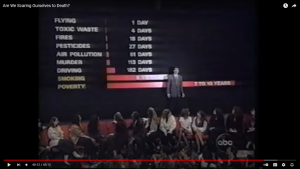Artifact 3
This time I chose the module 12 archive for my item to archive. I chose this artifact for the same reason I chose the last one, which is that it challenged the way I thought about the world in an interesting way. In this activity, I had to choose which actions from a list I would deem aggressive acts. What I found so interesting in this activity is that many of the items were technically aggressive according to the definition, but not actions that I would consider aggressive. This would include one example, where a man seeks to harm his mother by not writing her like he normally does. Technically, an act of aggression requires committing an act deliberately attempting to harm another person (Baron & Branscombe, 2017). While it technically is not an act of aggression due to the man not committing an action to harm, I still consider it aggressive. Likewise, I found I wouldnt consider a warden executing a prisoner to be aggressive even though I did consider a soldier shooting an enemy to be aggressive, and they are both technically acts of aggression (Baron & Branscombe, 2017).
I learned from this exercise that definitions can have emotional connections. I considered certain actions to be aggressive because they had a malicious intent, not because they actually fit the technical term. This was eye opening to the way that language and culture can shape my emotional reactions or assessments of situations, which is also a topic covered in our textbook (Baron & Branscombe, 2017). I found it interesting to see that topic in the real world especially as it applied to me.

https://sharpend.io/how-complex-web-systems-fail-part-1/
As I wrote in the archive, this picture represents the complexity of situations the activity presented to me. I was debating the morality of several different situations, and the emotional reaction that situations can produce compared to their definitions, as well as the connotations of words and the effect they have when applied to a situation. This exercise was a web of complexity.
References
Baron, R. A., & Branscombe, N. R. (2017). Social psychology (14th ed.). Pearson.
Artifact 2
My choice for my second top artifact was the module 7 item to archive. This was a self reported survey where I rated my agreement with several statements. These statements included sympathy for the homeless, safe driving practices, the necessity of exercise, and the productivity of recycling. I then had to answer whether I actually adhered to those beliefs in my own behaviors. What I found was that for some of my beliefs, such as exercise and recycling, I followed my beliefs with my actions. For other beliefs, such as supporting the homeless or preparing for class by reading the materials, I did not act in alignment with my beliefs.
The exercise made me question why my actions appeared to differ from my beliefs, and in doing so it made me engage in my own cognitive dissonance, which I found fascinating. I found myself justifying ignoring the homeless because I might need the money for something myself. I also excused my lack of aid to the homeless by claiming it was a macro level problem and nothing I could do besides voting could make a real impact.
It grew my understanding of myself and forced me to confront inconsistencies in my behavior. I also found myself cementing the reasons for my behavior when I never before had to do so. Only by confronting myself with some of these questions was I able to find this out about myself.

https://www.newyorker.com/humor/daily-shouts/cognitive-dissonances-im-comfortable-with
I chose this image for my artifact because it is an example of the illustrators personal cognitive dissonance. She believes social media creates a cycle of envy, yet also posts her own exotic vacations knowing it will make others envious. I found this to be humorous, and it is something that I feel like doing despite feeling the same way about it as the illustrator.
Artifact 1
My choice for my top artifact this time was the module 4 item to archive. This entailed a video presentation done in the 1990s which detailed how people’s fear of certain events, including things like airplane crashes, chemical dangers, violent crime, etc. were greatly exagerrated. Other causes of death were much more prominent but went ignored. What I learned from this activity was that a lot of dangers that the media focuses on are not actually that important, frequent, or relevent. In particular, there was one section in the video where he discussed a study having found high lead levels in the ground of a small town. Despite widespread media coverage and EPA pressure to relocate the neighborhood and undertake a massive cleaning project, it was eventually determined that the lead posed almost no actual risk to the residents.
I found this to be a great example of media frenzy and over exaggeration of risks. Equally fascinating was the section where he presented real data on plane crashes, pollution, and murder. They were significantly less likely and less dangerous than everyday things like driving smoking. I completely agreed with his point that there is too much of a focus on things that aren’t as important, and an ignorance of the risks most likely to actually effect people.

Image: https://www.youtube.com/watch?v=WmiFShBQDIs
I chose this image because it shows his graph comparing the real risk of various things, with a focus on how smoking, driving, and poverty have a substancially higher statistical risk and impact that things like flying or toxic waste.